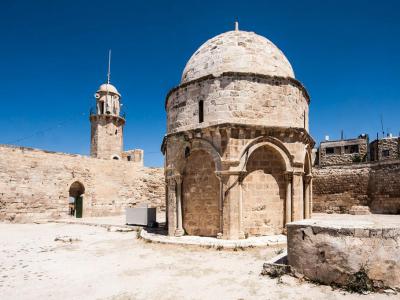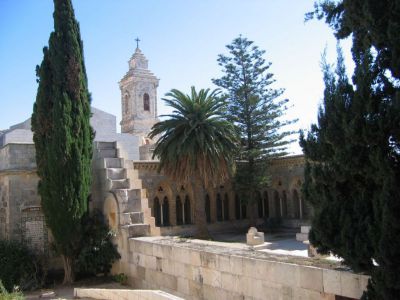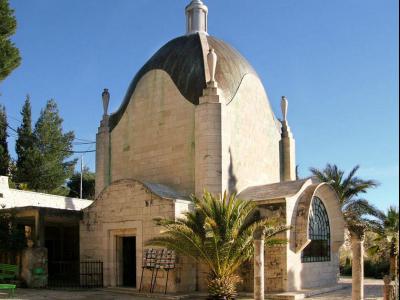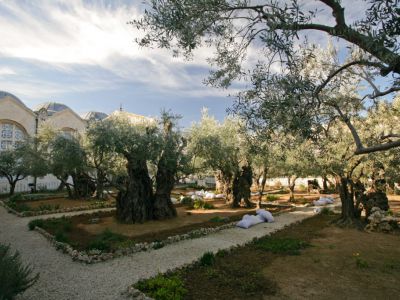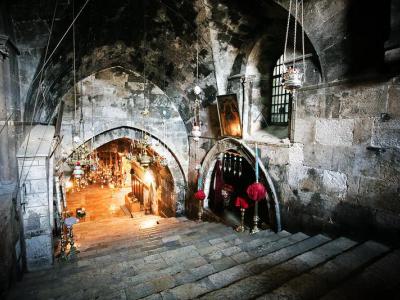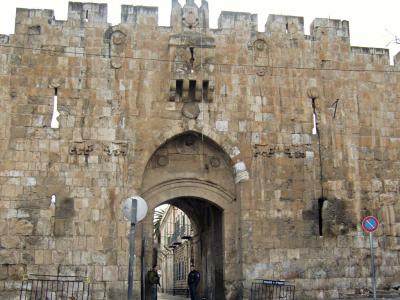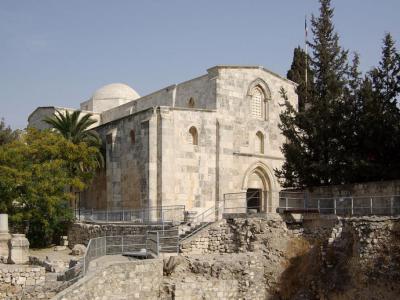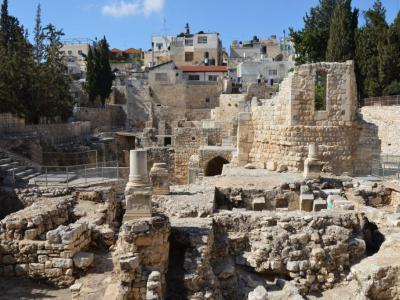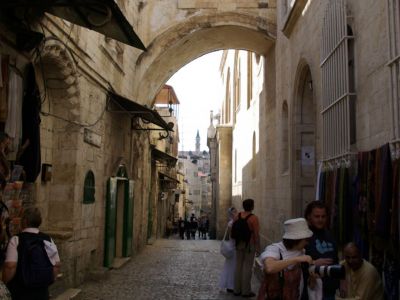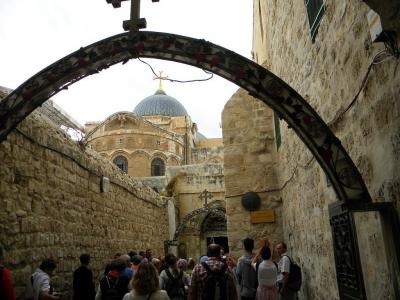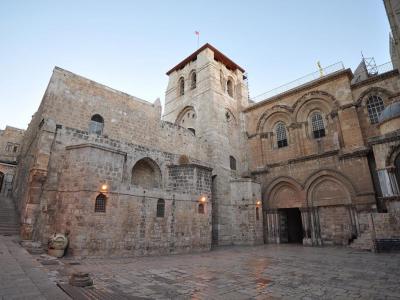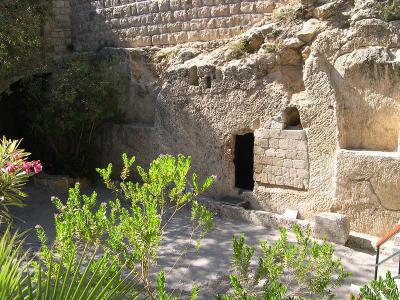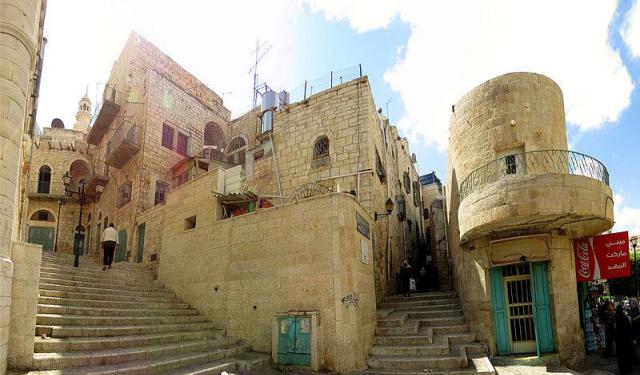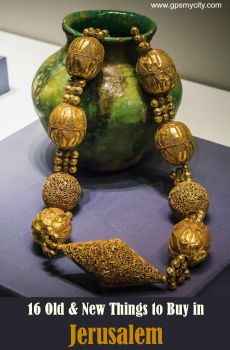Following Steps of Jesus Walking Tour (Self Guided), Jerusalem
Considered for centuries to be the center of the universe, Jerusalem is where the most famous figure in history, Jesus of Nazareth, fulfilled his divine mission by carrying a cross from the place of Pontius Pilate’s sentencing to Golgotha where he was crucified. This self-guided tour will retrace the steps of Jesus, allowing you to see what many consider some of the holiest places on our planet.
To take in all the sights it is wisest to start at the top of the Mount of Olives, near the Chapel of the Ascension, and walk downhill to the Tomb of the Virgin. The Old City panoramas are best in the morning, and the view of the Dome of the Rock from the Dominus Flevit’s altar window is justly famous. While the exact location of Jesus’s prayer and reflection is not known, it was in the general location of the Garden of Gethsemane – still a hive of olive trees.
Passing through the Lion’s Gate from the mount into the Old City, just like Jesus did, you will enter a quiet courtyard with trees and flowers for some rest. The compound contains the Church of St Anne and the large excavation area of the Pools of Bethesda, whose waters, believed to have medicinal qualities, were used by Jesus to cure a man who “had an infirmity thirty and eight years”, according to the Gospel of St John.
Walk the Stations of the Cross – the path that Jesus walked carrying the cross to Calvary. Via Dolorosa, all within the ancient city walls, is breathtaking and humbling at the same time. Go inside the Church of the Holy Sepulchre and visit the tomb as well as the stone where Jesus was anointed with oils and wrapped in burial cloths.
Our self-guided walk takes you to these and other significant places to be experienced without need of a guide. Give it a shot!
To take in all the sights it is wisest to start at the top of the Mount of Olives, near the Chapel of the Ascension, and walk downhill to the Tomb of the Virgin. The Old City panoramas are best in the morning, and the view of the Dome of the Rock from the Dominus Flevit’s altar window is justly famous. While the exact location of Jesus’s prayer and reflection is not known, it was in the general location of the Garden of Gethsemane – still a hive of olive trees.
Passing through the Lion’s Gate from the mount into the Old City, just like Jesus did, you will enter a quiet courtyard with trees and flowers for some rest. The compound contains the Church of St Anne and the large excavation area of the Pools of Bethesda, whose waters, believed to have medicinal qualities, were used by Jesus to cure a man who “had an infirmity thirty and eight years”, according to the Gospel of St John.
Walk the Stations of the Cross – the path that Jesus walked carrying the cross to Calvary. Via Dolorosa, all within the ancient city walls, is breathtaking and humbling at the same time. Go inside the Church of the Holy Sepulchre and visit the tomb as well as the stone where Jesus was anointed with oils and wrapped in burial cloths.
Our self-guided walk takes you to these and other significant places to be experienced without need of a guide. Give it a shot!
How it works: Download the app "GPSmyCity: Walks in 1K+ Cities" from Apple App Store or Google Play Store to your mobile phone or tablet. The app turns your mobile device into a personal tour guide and its built-in GPS navigation functions guide you from one tour stop to next. The app works offline, so no data plan is needed when traveling abroad.
Following Steps of Jesus Walking Tour Map
Guide Name: Following Steps of Jesus Walking Tour
Guide Location: Israel » Jerusalem (See other walking tours in Jerusalem)
Guide Type: Self-guided Walking Tour (Sightseeing)
# of Attractions: 12
Tour Duration: 2 Hour(s)
Travel Distance: 3.7 Km or 2.3 Miles
Author: vickyc
Sight(s) Featured in This Guide:
Guide Location: Israel » Jerusalem (See other walking tours in Jerusalem)
Guide Type: Self-guided Walking Tour (Sightseeing)
# of Attractions: 12
Tour Duration: 2 Hour(s)
Travel Distance: 3.7 Km or 2.3 Miles
Author: vickyc
Sight(s) Featured in This Guide:
- Chapel of the Ascension
- Church of the Pater Noster
- Dominus Flevit Church
- Garden of Gethsemane
- Tomb of the Virgin Mary
- Lions' Gate
- Churches of St. Anne
- Pools of Bethesda
- Ecce Homo Arch
- Via Dolorosa (Way of Sorrow)
- Church of the Holy Sepulchre / Christ's Tomb
- Garden Tomb
1) Chapel of the Ascension
The Chapel of the Ascension is part of a larger complex with a rich history, transitioning from a Christian church and monastery to an Islamic mosque. Tradition holds that this site marks the spot where Jesus "was carried up into heaven" forty days after his resurrection, leaving behind a footprint on the rock inside the octagonal shrine.
Before Emperor Constantine's conversion to the faith, early Christians commemorated Christ's ascension in a cave on the Mount of Olives, likely used for worship gatherings due to its safety. Around 390, a chapel was built here by Poimenia, a prominent Roman woman; however, the current building was constructed by the Crusaders and later converted into a mosque by Salah ad-Din in 1198, with a mihrab pointing towards Mecca (in the south wall) added shortly after. The presence of a mosque on the site is not as bizarre as it might seem, considering that Islam recognizes Jesus as a prophet.
The adjacent tiny burial crypt is revered by adherents of all three Abrahamic religions: Jews believe it holds the prophetess Huldah from the 7th century BCE, Christians associate it with the 5th-century saint Pelagia the Harlot (or Penitent), and Muslims attribute it to the 8th-century Sufi mystic Rabi'a al-Adawiyya. What is certain is that the Christian tradition of Saint Pelagia is the oldest.
Before Emperor Constantine's conversion to the faith, early Christians commemorated Christ's ascension in a cave on the Mount of Olives, likely used for worship gatherings due to its safety. Around 390, a chapel was built here by Poimenia, a prominent Roman woman; however, the current building was constructed by the Crusaders and later converted into a mosque by Salah ad-Din in 1198, with a mihrab pointing towards Mecca (in the south wall) added shortly after. The presence of a mosque on the site is not as bizarre as it might seem, considering that Islam recognizes Jesus as a prophet.
The adjacent tiny burial crypt is revered by adherents of all three Abrahamic religions: Jews believe it holds the prophetess Huldah from the 7th century BCE, Christians associate it with the 5th-century saint Pelagia the Harlot (or Penitent), and Muslims attribute it to the 8th-century Sufi mystic Rabi'a al-Adawiyya. What is certain is that the Christian tradition of Saint Pelagia is the oldest.
2) Church of the Pater Noster
Past a grove of ancient olive trees, this church, set within an enclosed garden, was built over the grotto (cave) where Jesus is believed to have preached about the ultimate conflict of good and evil leading to the end of the world. The Crusaders, believing it to also be the place where Jesus taught his disciples the Lord's Prayer, gave the church its present name – "Pater Noster", Latin for "Our Father".
The original Eleona Basilica ("Basilica of Olives"), commissioned by Emperor Constantine in AD 326, with supervision by his mother, Saint Helena, was destroyed by the Persians 300 years later. While its ruins have been partly restored and are of interest to visitors, the current building dates back to the late 19th century when it was overseen by contemplative Carmelite nuns.
Inside, a short flight of stairs from the south side of the open courtyard leads to the tomb of the Princesse de la Tour d'Auvergne who acquired the property in 1868 and had the Lord's Prayer inscribed in 62 languages on exquisitely tiled panels in the entrance and cloister (their number has more than doubled since then, also including various dialects).
Tip:
If you have trouble finding the panel in your language, ask for help in the shop, as they have a map of all panels and plaques.
The original Eleona Basilica ("Basilica of Olives"), commissioned by Emperor Constantine in AD 326, with supervision by his mother, Saint Helena, was destroyed by the Persians 300 years later. While its ruins have been partly restored and are of interest to visitors, the current building dates back to the late 19th century when it was overseen by contemplative Carmelite nuns.
Inside, a short flight of stairs from the south side of the open courtyard leads to the tomb of the Princesse de la Tour d'Auvergne who acquired the property in 1868 and had the Lord's Prayer inscribed in 62 languages on exquisitely tiled panels in the entrance and cloister (their number has more than doubled since then, also including various dialects).
Tip:
If you have trouble finding the panel in your language, ask for help in the shop, as they have a map of all panels and plaques.
3) Dominus Flevit Church
Its name meaning "The Lord Wept", this Franciscan chapel on the western slope of the Mount of Olives recalls the incident described in the Gospels where Jesus, while riding toward Jerusalem on the first Palm Sunday, had his "great lament" for the future fate of the Jewish people and of the Second Temple. Designed by Italian architect Antonio Barluzzi to stylize the shape of a teardrop, it was built in the 1950s on the ruins of a 7th-century chapel, with part of the original apse preserved.
The views over the Dome of the Rock and the Old City from both the altar window and the serene gardens are justly famous and enough to justify a visit. Rich in symbolism, both physically and spiritually, Dominus Flevit also has a collection of carved stone ossuaries (100 BC to 300 AD) one can observe just after entering its gates and, more importantly perhaps, a fine early Christian mosaic from a 5th-century monastery, preserved in situ outdoors, to the side of the church door.
The views over the Dome of the Rock and the Old City from both the altar window and the serene gardens are justly famous and enough to justify a visit. Rich in symbolism, both physically and spiritually, Dominus Flevit also has a collection of carved stone ossuaries (100 BC to 300 AD) one can observe just after entering its gates and, more importantly perhaps, a fine early Christian mosaic from a 5th-century monastery, preserved in situ outdoors, to the side of the church door.
4) Garden of Gethsemane (must see)
A place of great resonance in Christianity, this beautiful walled garden at the foot of the Mount of Olives, revered since the apostolic period, is the site where – according to the four Gospels of the New Testament – Jesus experienced the agonizing premonition of his passion and death, and where he was arrested the night before his crucifixion. The name "Gethsemane" is derived from Aramaic and means "oil press," likely indicating that the area was once used for pressing olive oil.
Beyond the religious significance, the garden is essentially an urban olive orchard, with eight distinctive ancient trees among others. Carbon dating estimates the eight trees to be over 900 years old (as such, amongst the oldest known to science), having descended from the same parent tree – possibly itself a descendant from the original trees of Christ's time. They still produce fruit but are fenced off so unless you gracefully tip the gatekeeper, you can't go walking among them.
Also be sure to visit the adjacent Church of All Nations on the grounds, also known as the Basilica of the Agony, which holds a section of bedrock believed to be where Jesus prayed before his arrest – but make very sure your knees, shoulders and upper arms are properly covered, preferably with clothing and not just a shawl, or you will be refused entry. Women should avoid wearing shorts of any length.
Beyond the religious significance, the garden is essentially an urban olive orchard, with eight distinctive ancient trees among others. Carbon dating estimates the eight trees to be over 900 years old (as such, amongst the oldest known to science), having descended from the same parent tree – possibly itself a descendant from the original trees of Christ's time. They still produce fruit but are fenced off so unless you gracefully tip the gatekeeper, you can't go walking among them.
Also be sure to visit the adjacent Church of All Nations on the grounds, also known as the Basilica of the Agony, which holds a section of bedrock believed to be where Jesus prayed before his arrest – but make very sure your knees, shoulders and upper arms are properly covered, preferably with clothing and not just a shawl, or you will be refused entry. Women should avoid wearing shorts of any length.
5) Tomb of the Virgin Mary
Tucked away in the Valley of Jehoshaphat, just beyond the City Walls and alongside Gethsemane, lies a sanctuary steeped in mystique: the underground chamber believed to be the resting place of the Virgin Mary. What sets this site apart is its unique entrance – a descent down nearly 50 Crusader-built steps, a symbolic journey into the depths of faith.
The unassuming facade belies the rich history within, marked by the grand staircase erected by the Crusaders and the side tombs halfway down, purportedly reserved for royal burials during the 12th century. Among these, the tomb on the right, descending, holds special reverence as the resting place of Saints Anne and Joachim, parents of Mary.
The roots of this sanctum trace back to the 1st century AD, with the current cruciform crypt, predominantly hewn from solid rock, reflecting Byzantine craftsmanship. Within its eastern branch, adorned with icons and embellishments, stands the Tomb of Mary, a focal point of veneration for Armenian, Greek, Coptic, and Syrian Christians alike. Interestingly, Muslims also hold this site sacred, as legend has it that Muhammad witnessed a divine light emanating from the tomb of his "sister Mary" during his Night Journey to Jerusalem. Outside, adjacent to the facade, lies the Cave of Gethsemane, also known as the Cave of the Betrayal, where tradition places Judas's infamous act.
The unassuming facade belies the rich history within, marked by the grand staircase erected by the Crusaders and the side tombs halfway down, purportedly reserved for royal burials during the 12th century. Among these, the tomb on the right, descending, holds special reverence as the resting place of Saints Anne and Joachim, parents of Mary.
The roots of this sanctum trace back to the 1st century AD, with the current cruciform crypt, predominantly hewn from solid rock, reflecting Byzantine craftsmanship. Within its eastern branch, adorned with icons and embellishments, stands the Tomb of Mary, a focal point of veneration for Armenian, Greek, Coptic, and Syrian Christians alike. Interestingly, Muslims also hold this site sacred, as legend has it that Muhammad witnessed a divine light emanating from the tomb of his "sister Mary" during his Night Journey to Jerusalem. Outside, adjacent to the facade, lies the Cave of Gethsemane, also known as the Cave of the Betrayal, where tradition places Judas's infamous act.
6) Lions' Gate
This gate on Jerusalem's eastern ramparts is known by multiple names. While commonly referred to as the Lions' Gate due to the pair of beasts flanking the entrance, it is also called Saint Stephen's Gate after the first Christian martyr who was stoned to death outside the city. His tomb was originally located near the Damascus Gate but was later relocated here for the convenience of Christian pilgrims.
In Arabic, the gate is known as Bab al-Ghor ("Jordan Valley Gate") or "Gate of Our Lady Mary", since the Virgin is believed to have been born just inside. Yet another Arabic name is Meshikuli, which in more modern terms would mean "wicket" – a small opening in a wall – through which, back in the day, people could observe approaching enemies and, in case of attack, pour boiling oil or tar onto their heads.
Legend has it that the emblematic lions flanking the gateway (although one school of thought insists that they are panthers) were originally symbols of the Mamluk sultan Baybars I and were placed there by Suleiman the Magnificent in celebration of his successful campaign to rid the Holy Land of Crusaders. Another story suggests that Suleiman had the panthers installed after dreaming that he would be eaten by lions if he didn't rebuild Jerusalem's ramparts.
Despite its age and historical significance, the Lions' Gate remains remarkably well-preserved, having never undergone restoration. Visitors should be prepared for crowds, particularly on Fridays when Muslims gather for prayer at the nearby Al-Aqsa Mosque.
In Arabic, the gate is known as Bab al-Ghor ("Jordan Valley Gate") or "Gate of Our Lady Mary", since the Virgin is believed to have been born just inside. Yet another Arabic name is Meshikuli, which in more modern terms would mean "wicket" – a small opening in a wall – through which, back in the day, people could observe approaching enemies and, in case of attack, pour boiling oil or tar onto their heads.
Legend has it that the emblematic lions flanking the gateway (although one school of thought insists that they are panthers) were originally symbols of the Mamluk sultan Baybars I and were placed there by Suleiman the Magnificent in celebration of his successful campaign to rid the Holy Land of Crusaders. Another story suggests that Suleiman had the panthers installed after dreaming that he would be eaten by lions if he didn't rebuild Jerusalem's ramparts.
Despite its age and historical significance, the Lions' Gate remains remarkably well-preserved, having never undergone restoration. Visitors should be prepared for crowds, particularly on Fridays when Muslims gather for prayer at the nearby Al-Aqsa Mosque.
7) Churches of St. Anne (must see)
Inside the Lions' Gate, within a walled compound, stand two Churches of Saint Anne, both named after the mother of the Virgin Mary. The Greek Orthodox church, located nearest to the Lions' Gate, features a small cave-like chapel believed by Greek Orthodox tradition to be the site of Mary's birth. Downstairs, visitors can view the tombs of Mary's parents, Saints Anne and Joachim. The church welcomes visitors during specified hours, and a donation is typically expected.
Adjacent to the Greek Orthodox church is the 12th-century Greek Catholic church, open for visitation from Monday to Saturday. Considered one of the simplest yet most beautiful Crusader buildings in the region, it blends Romanesque architecture with Middle Eastern elements such as pointed arches and fluted fringe around the uppermost window (the Crusaders later introduced these very features to Europe). Inside, the unadorned columns and vaulting create a light and airy atmosphere. Due to the perfect acoustics ideal for choral singing, many pilgrim groups visit specifically to experience the remarkable reverberations of hymns sung within.
Descending stairs lead to the ancient crypt with mosaics and columns dating back to Byzantine times, where Catholic tradition places Mary's birth, though priests today refrain from asserting dogma on the matter.
Tips:
An intriguing aspect here is the asymmetrical design, which visitors can observe by counting the number of steps on each side. And, as an extra, there is an extremely beautiful church garden!
Adjacent to the Greek Orthodox church is the 12th-century Greek Catholic church, open for visitation from Monday to Saturday. Considered one of the simplest yet most beautiful Crusader buildings in the region, it blends Romanesque architecture with Middle Eastern elements such as pointed arches and fluted fringe around the uppermost window (the Crusaders later introduced these very features to Europe). Inside, the unadorned columns and vaulting create a light and airy atmosphere. Due to the perfect acoustics ideal for choral singing, many pilgrim groups visit specifically to experience the remarkable reverberations of hymns sung within.
Descending stairs lead to the ancient crypt with mosaics and columns dating back to Byzantine times, where Catholic tradition places Mary's birth, though priests today refrain from asserting dogma on the matter.
Tips:
An intriguing aspect here is the asymmetrical design, which visitors can observe by counting the number of steps on each side. And, as an extra, there is an extremely beautiful church garden!
8) Pools of Bethesda
In the compound housing the Catholic Saint Anne's church, visitors can explore the ruins of the two historic Pools of Bethesda, constructed around 200 BC to supply water to the Temple. According to the Gospel of Saint John, these waters were believed to possess healing properties and were used by Jesus to cure a man who had been afflicted for thirty-eight years.
Excavations reveal the remains of the five porches mentioned in the Gospel, with nearby natural caves adapted as baths for the thousands of sufferers who sought healing during Roman times. Visitors can also observe the remnants of a 3rd-century temple to Serapis built by the Romans on the site, which was later replaced by a basilica during the Byzantine era.
As visitors follow the walkway around the pools, they can descend into the depths of a Roman cistern and explore the various archaeological features, with a detailed plan onsite providing guidance. Additionally, a small museum displays objects found during excavations, although it is typically open only by appointment.
Excavations reveal the remains of the five porches mentioned in the Gospel, with nearby natural caves adapted as baths for the thousands of sufferers who sought healing during Roman times. Visitors can also observe the remnants of a 3rd-century temple to Serapis built by the Romans on the site, which was later replaced by a basilica during the Byzantine era.
As visitors follow the walkway around the pools, they can descend into the depths of a Roman cistern and explore the various archaeological features, with a detailed plan onsite providing guidance. Additionally, a small museum displays objects found during excavations, although it is typically open only by appointment.
9) Ecce Homo Arch
The arch that spans the Via Dolorosa was originally built by the Romans in AD 70 to support a ramp against the Antonia Fortress, where Jewish rebels were barricaded. When the Romans rebuilt Jerusalem in AD 135 following the Second Jewish War, the arch was reconstructed as a monument to their victory. featuring two smaller arches flanking a large central bay. It is this central bay that spans the street just west of the entrance to the Lithostratos ("Pavement of Justice").
One of the side arches is still visible today, integrated into the interior of the neighboring Convent of the Sisters of Zion, which was built in the 1860s. Within the convent lie the remains of the ancient Pool of the Sparrow (Struthion), a reservoir that collected rainwater from rooftops. According to Christian tradition, it was on the stone pavement covering this pool that Pontius Pilate presented Jesus to the crowds, uttering the famous words "Ecce homo" ("Behold the man"). However, archaeological findings date the pavement to the 2nd century AD, during the reign of Hadrian, long after the time of Christ.
Marks scratched into the stone, visible within a railed section, are speculated by historians to have been made by Roman guards as a form of street game. Meanwhile, adjacent to the arch and the Third Station, on the north side of the street, a building belonging to the Greek Orthodox Patriarchate, (though not accessible to the public), bears a plaque identifying it as the Prison of Jesus and Barabas. This tradition was only established in 1911, however, and it is more likely that the structure was a stable associated with the Antonia Fortress.
One of the side arches is still visible today, integrated into the interior of the neighboring Convent of the Sisters of Zion, which was built in the 1860s. Within the convent lie the remains of the ancient Pool of the Sparrow (Struthion), a reservoir that collected rainwater from rooftops. According to Christian tradition, it was on the stone pavement covering this pool that Pontius Pilate presented Jesus to the crowds, uttering the famous words "Ecce homo" ("Behold the man"). However, archaeological findings date the pavement to the 2nd century AD, during the reign of Hadrian, long after the time of Christ.
Marks scratched into the stone, visible within a railed section, are speculated by historians to have been made by Roman guards as a form of street game. Meanwhile, adjacent to the arch and the Third Station, on the north side of the street, a building belonging to the Greek Orthodox Patriarchate, (though not accessible to the public), bears a plaque identifying it as the Prison of Jesus and Barabas. This tradition was only established in 1911, however, and it is more likely that the structure was a stable associated with the Antonia Fortress.
10) Via Dolorosa (Way of Sorrow) (must see)
Via Dolorosa, or "the Way of Sorrow" in Christian tradition, is the path believed to have been taken by Jesus from Pilate's judgment hall to Golgotha, where he was crucified. This route, traversed by countless pilgrims, begins at the Madrasa al-Omariya, located 300 meters west of the Lions' Gate in the Muslim Quarter, and concludes at the Church of the Holy Sepulchre. Along its 500-meter length are the fourteen Stations of the Cross, each commemorating an event in the Gospel narrative. While these stations are a relatively recent addition, with some established only in the 19th century, they are marked by black iron plaques bearing Roman numerals.
One way to ensure finding all fourteen stations and experience the devotional atmosphere is to join the Franciscans' procession. Led by Franciscan friars, who have been appointed guardians of Jerusalem's holy sites since 1342, the procession typically begins at the Umariya School, the First Station of the Cross, on Fridays at 3 PM in winter or 4 PM during daylight saving time, aligning as closely as possible with the time and day of Jesus's original ordeal.
It's important to note that the cobbled stone path can be slippery, especially when wet, and certain sections may have steep inclines with stairs. The area can be crowded and bustling, so visitors should exercise caution and be prepared to move quickly. Consider joining a tour or bringing a comprehensive map or guidebook. Also, have your camera ready! Besides its spiritual significance, the area has impressive artwork and architecture worth exploring.
One way to ensure finding all fourteen stations and experience the devotional atmosphere is to join the Franciscans' procession. Led by Franciscan friars, who have been appointed guardians of Jerusalem's holy sites since 1342, the procession typically begins at the Umariya School, the First Station of the Cross, on Fridays at 3 PM in winter or 4 PM during daylight saving time, aligning as closely as possible with the time and day of Jesus's original ordeal.
It's important to note that the cobbled stone path can be slippery, especially when wet, and certain sections may have steep inclines with stairs. The area can be crowded and bustling, so visitors should exercise caution and be prepared to move quickly. Consider joining a tour or bringing a comprehensive map or guidebook. Also, have your camera ready! Besides its spiritual significance, the area has impressive artwork and architecture worth exploring.
11) Church of the Holy Sepulchre / Christ's Tomb (must see)
One of the most revered destinations in the Old City, this site holds unparalleled significance for Christians worldwide. Commonly referred to as the Church of the Resurrection, its somber, cavernous interior encompasses four stations of the Via Dolorosa, drawing crowds of pilgrims year-round. (The terminus of the Via Dolorosa lies just beyond the expansive outdoor courtyard.)
Welcoming visitors at the entrance is the Chapel of the Franks, leading to the towering interior featuring a Greek Orthodox crucifixion altar, believed to mark the spot of Jesus' crucifixion. Adjacent to it, the prominent Stone of Unction serves as a reminder of the place where Jesus's body was prepared for burial. Further inside, past the Chapel of the Angel, lies a marble-encased tomb, purportedly the very place where Jesus was laid to rest. A majestic vaulted dome crowns the tomb, emanating a solemn stream of light from above.
Commissioned by Constantine the Great following his conversion to Christianity in AD 326, the church has weathered centuries of neglect, desecration, and damage amid shifting rulership in the city. A collaborative restoration effort in 1959, spearheaded by the Latin, Greek, and Armenian communities, preserved what could be salvaged. The resulting structure is a patchwork of Byzantine, Crusader, medieval, and modern architectural styles. Control of the church is scrupulously divided among various Christian denominations, with disputes over custodial responsibilities even extending to the cleaning of steps.
Tip:
It's advisable to arrive early and come prepared, as signage and guided tours are scarce. Proper attire is essential for entry.
Welcoming visitors at the entrance is the Chapel of the Franks, leading to the towering interior featuring a Greek Orthodox crucifixion altar, believed to mark the spot of Jesus' crucifixion. Adjacent to it, the prominent Stone of Unction serves as a reminder of the place where Jesus's body was prepared for burial. Further inside, past the Chapel of the Angel, lies a marble-encased tomb, purportedly the very place where Jesus was laid to rest. A majestic vaulted dome crowns the tomb, emanating a solemn stream of light from above.
Commissioned by Constantine the Great following his conversion to Christianity in AD 326, the church has weathered centuries of neglect, desecration, and damage amid shifting rulership in the city. A collaborative restoration effort in 1959, spearheaded by the Latin, Greek, and Armenian communities, preserved what could be salvaged. The resulting structure is a patchwork of Byzantine, Crusader, medieval, and modern architectural styles. Control of the church is scrupulously divided among various Christian denominations, with disputes over custodial responsibilities even extending to the cleaning of steps.
Tip:
It's advisable to arrive early and come prepared, as signage and guided tours are scarce. Proper attire is essential for entry.
12) Garden Tomb (must see)
This archaeological site in a landscape setting, outside but within view of the city walls, holds a special appeal for Protestants seeking a more authentic sacred space than the traditional Church of the Holy Sepulchre. While the Anglican staff managing the site do not assert dogmatic claims regarding its authenticity as the tomb of Jesus' resurrection, its alignment with Gospel narratives makes it a compelling possibility for many and, more importantly, a visual reminder that "He is not here, for He is Risen!"
Regardless of religious affiliation, this spot is 'felt' by many as the most peaceful in Jerusalem, bringing a very welcome contrast to the noise of a very lively city. At the end of a visit, you will have seen a tomb that is at least similar to that of Jesus, and you will have heard a testimony of the saving power of the empty tomb. You will have experienced a communion of believers from so many different countries singing in their native languages. If you are a Christian, you will be truly moved; if you are a skeptic, you might be impressed, too.
Tip:
For those interested in a guided tour, emailing in advance is recommended. The tour typically lasts around 20 minutes, allowing ample time for personal reflection, reading, and photography amidst the tranquil surroundings.
Regardless of religious affiliation, this spot is 'felt' by many as the most peaceful in Jerusalem, bringing a very welcome contrast to the noise of a very lively city. At the end of a visit, you will have seen a tomb that is at least similar to that of Jesus, and you will have heard a testimony of the saving power of the empty tomb. You will have experienced a communion of believers from so many different countries singing in their native languages. If you are a Christian, you will be truly moved; if you are a skeptic, you might be impressed, too.
Tip:
For those interested in a guided tour, emailing in advance is recommended. The tour typically lasts around 20 minutes, allowing ample time for personal reflection, reading, and photography amidst the tranquil surroundings.
Walking Tours in Jerusalem, Israel
Create Your Own Walk in Jerusalem
Creating your own self-guided walk in Jerusalem is easy and fun. Choose the city attractions that you want to see and a walk route map will be created just for you. You can even set your hotel as the start point of the walk.
Jerusalem Old City Walking Tour
A UNESCO World Heritage Site since 1981, the Old City of Jerusalem is best explored on foot, since its narrow streets and alleys make it almost an entirely vehicle-free zone. In addition to hosting four ethnic quarters, – Jewish, Muslim, Christian and Armenian – it is packed with major historical and religious sites, which all make a trip here unique, unforgettable and not to be missed.
The... view more
Tour Duration: 3 Hour(s)
Travel Distance: 5.0 Km or 3.1 Miles
The... view more
Tour Duration: 3 Hour(s)
Travel Distance: 5.0 Km or 3.1 Miles
Muslim Quarter & Temple Mount Tour
The largest, most populous and perhaps most chaotic of all Jerusalem’s quarters, the Muslim Quarter is worth exploring for its unique atmosphere. Spending a day here may take you back to a simpler time, but be prepared for many sights and sounds as you pass many vendors, stores and restaurants on your way from site to site.
Some of the city’s most interesting city gates (Damascus and... view more
Tour Duration: 2 Hour(s)
Travel Distance: 2.1 Km or 1.3 Miles
Some of the city’s most interesting city gates (Damascus and... view more
Tour Duration: 2 Hour(s)
Travel Distance: 2.1 Km or 1.3 Miles
Mount Scopus Walking Tour
Dotted with many sightseeing places, Mount Scopus – translating as the “Observation Mount” from Greek – is a great place to get views over the whole Old City of Jerusalem on a nice day. The mount has been of major strategic importance since Roman times, with forces setting up camp here prior to laying the siege that culminated in the final Roman victory over Jerusalem around 70 AD.... view more
Tour Duration: 1 Hour(s)
Travel Distance: 2.3 Km or 1.4 Miles
Tour Duration: 1 Hour(s)
Travel Distance: 2.3 Km or 1.4 Miles
Armenian Quarter Walking Tour
Smaller and quieter than the Old City's other three quarters, the Armenian quarter contains a series of winding cobblestoned streets and alleyways teeming with people, shops, coffee stands, ceramic workshops and hookah bars. A city in miniature with distinct language, alphabet and culture, it has been in place since the 4th century, when Armenia adopted Christianity as a national religion.
... view more
Tour Duration: 1 Hour(s)
Travel Distance: 1.2 Km or 0.7 Miles
... view more
Tour Duration: 1 Hour(s)
Travel Distance: 1.2 Km or 0.7 Miles
Jerusalem City Gates Walking Tour
Historians believe that the Old City of Jerusalem probably came into being more than 4,500 years ago. The defensive wall around it features a number of gates built on the order of the Ottoman sultan Suleyman the Magnificent in the first half of the 16th century, each of which is an attraction in its own right. Until as recently as 1870, they were all closed from sunset to sunrise; nowadays, just... view more
Tour Duration: 2 Hour(s)
Travel Distance: 3.7 Km or 2.3 Miles
Tour Duration: 2 Hour(s)
Travel Distance: 3.7 Km or 2.3 Miles
Bethlehem Walking Tour
Perched on a hill at the edge of the Judaean Desert, Bethlehem has been known to the world, for more than two millennia, as the birthplace of Jesus Christ. The “star of Bethlehem” as well as Christmas carols and hymns are firmly associated with this ancient city in the West Bank, Palestine, and thus, for some visitors, the bustle of a modern city may come as a surprise.
Undoubtedly, the... view more
Tour Duration: 1 Hour(s)
Travel Distance: 1.5 Km or 0.9 Miles
Undoubtedly, the... view more
Tour Duration: 1 Hour(s)
Travel Distance: 1.5 Km or 0.9 Miles
Useful Travel Guides for Planning Your Trip
16 Uniquely Israel Things to Buy in Jerusalem
Modern day Jerusalem is a mosaic of neighborhoods, reflecting different historical periods, cultures, and religions. The influx of repatriates in recent years has made the cultural and artisanal scene of the city even more colourful and diverse. To find your way through Jerusalem's intricate...
The Most Popular Cities
/ view all



